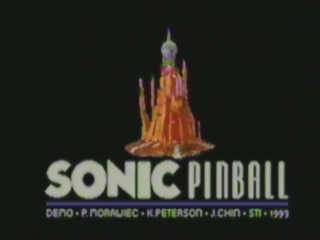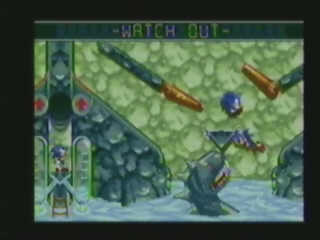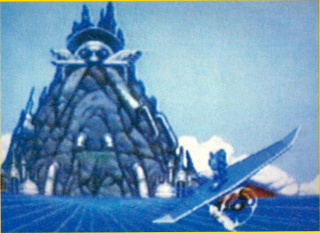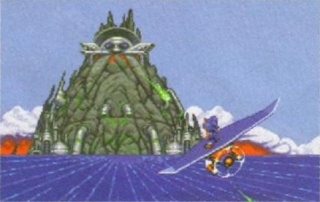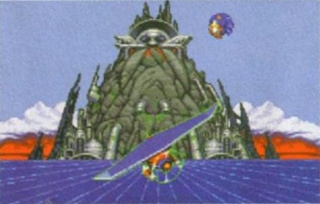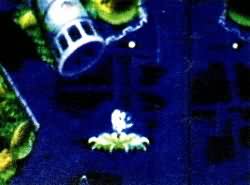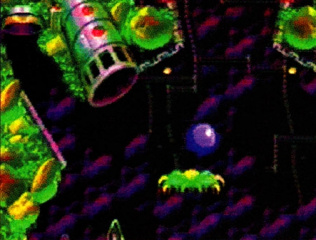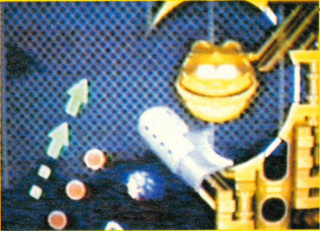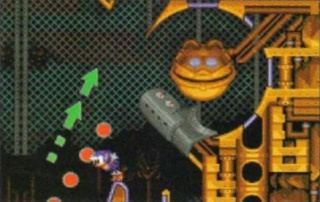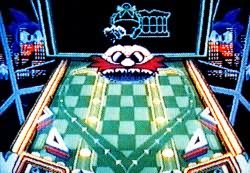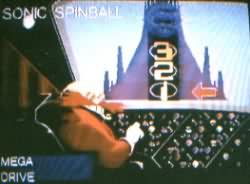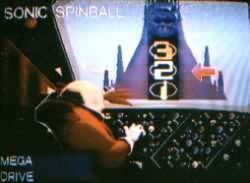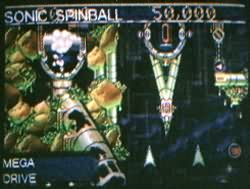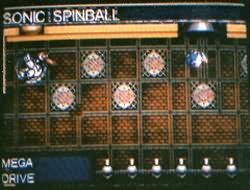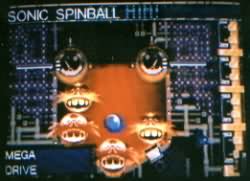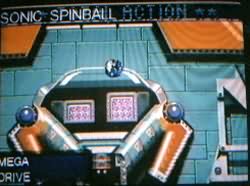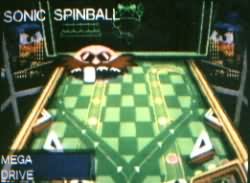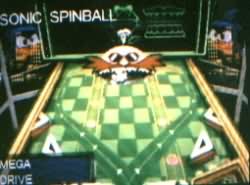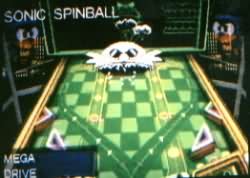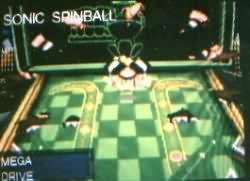Difference between revisions of "Sonic the Hedgehog Spinball/Development"
From Sonic Retro
(→Screenshots) |
m (→Audio: +proto leak date) |
||
| (24 intermediate revisions by 5 users not shown) | |||
| Line 1: | Line 1: | ||
| − | + | {{back}}[[Category:Development]] | |
| + | [[File:PeterMorawiec.jpg|thumb|right|280px|[[Peter Morawiec]], ''Spinball'''s lead designer.]] | ||
| + | __TOC__ | ||
| + | While the release of ''[[Sonic the Hedgehog 2 (16-bit)|Sonic the Hedgehog 2]]'' would be a tremendous success, allowing the ''Sonic the Hedgehog'' franchise, and [[Sega]] as a whole, to soar to new heights during 1993, development was challenging. Developed by the [[Sega Technical Institute]] (STI), ''Sonic 2'' was a joint project between development staff brought over from Japan, and the American team behind the likes of ''[[Dick Tracy]]'' and ''[[Kid Chameleon]]'', an idea instrumented by [[Mark Cerny]] to have Japanese "mentors" improve the output of Sega's American produce. | ||
| − | [[ | + | Language and cultural differences meant [[Yuji Naka]] and others wanted to abandon the "experiment" for the next logical step, ''[[Sonic the Hedgehog 3]]'', so the Japanese staff would work on ''Sonic 3'' while the Americans would be placed on other projects. However, when it became clear ''Sonic 3'' was unlikely to make a Christmas 1993 release date, a number of smaller ''Sonic the Hedgehog'' games were commissioned to capitalize on the most profitable trading season of the year. One of these would become ''[[Sonic the Hedgehog Spinball (16-bit)|Sonic Spinball]]''{{intref|Interview: Peter Morawiec (2007-04-20) by Sega-16}}. |
| − | [[ | + | A "Sonic Pinball" pitch was put together by [[Peter Morawiec]] and others at STI, featuring a short animation demo created with an Amiga computer, inspired by the pinball elements of the [[Casino Night Zone]] stage of ''Sonic 2'. The project was greenlit, and the retitled ''Sonic Spinball'' would commence development, being created by an entirely American team with virtually no input from the Japanese ''Sonic'' developers. it stands as the first entirely Western-produced ''Sonic'' game, and the first specifically designed with a Western audience in mind. |
| − | + | The third-party development studio [[Polygames]] handled around 90% of the programming, while STI members handled the graphics, design, and music. The game was produced in the span of nine months, with Polygames founders [[sega:Lee Actor|Lee Actor]] and [[sega:Dennis Koble|Dennis Koble]] being hired as programmers to get the project out the door. ''Spinball'' was programmed in the C programming language, when the norm for Mega Drive games of the era was 68K assembly.{{intref|Interview: Peter Morawiec (2007-04-20) by Sega-16}} | |
| − | |||
| − | |||
| − | |||
| − | |||
| − | |||
| − | |||
| − | |||
| − | |||
| − | |||
| − | |||
| − | |||
| − | |||
| − | Early concept art depicts the [[Veg-O-Fortress]] as a | + | ==Rounds== |
| + | [[File:Sonic Spinball game rounds concept art.jpg|right|thumb|The early map.]] | ||
| + | Early concept art depicts the [[Veg-O-Fortress]] being used as a map screen:{{fileref|Sonic Spinball game rounds concept art.jpg}} | ||
| + | #Underground Caves | ||
| + | #Toxic Pools | ||
| + | #[[Lava Powerhouse]] | ||
| + | #[[The Machine]] | ||
| + | #Eruption | ||
| − | + | The final game contains only four rounds, with "[[Underground Caves]]" and "Toxic Pools" combined to produce [[Toxic Caves]]{{intref|Interview: Craig Stitt (2001-01-23) by ICEknight}}. In the [[Sonic Spinball (8-bit)|8-bit version]], the name [[Toxic Pools]] is retained. Meanwhile, ''Eruption'' was renamed [[Showdown]] in the 16-bit version and [[Final Showdown]] in the 8-bit version. | |
| − | |||
| − | |||
| − | |||
| − | |||
| − | + | ==Audio== | |
| + | Three groups contributed music and sound effects to the game: [[Sega Multimedia Studio]], [[sega:OUI Multimedia|OUI Multimedia]] and [[Sega Technical Institute]] itself.{{intref|sega:Sonic the Hedgehog Spinball/Production credits}} In June 1993,{{ref|https://archive.ph/vuZgK|https://www.linkedin.com/in/howarddrossin/}} STI hired its first in-house composer [[Howard Drossin]]. By the afternoon of his first day of work he had composed the music for [[Toxic Caves]], thinking he would simply test out the Mega Drive hardware, but was pleasantly surprised when the music was approved for the final release.{{ref|https://www.thesegalounge.com/117-howarddrossin1/}}{{intref|sega:ComixZone Vinyl US booklet.pdf|page=2}} | ||
| − | ' | + | During the soundtrack's production, Drossin reached out to Sega Multimedia Studio audio director [[David Javelosa]] for assistance. Javelosa's close friend and later staff hire [[Barry Blum]] contributed "some killer tracks on ''Spinball''", and while Javelosa recalls that he himself may have provided some instrument patches and sound effects for the project, he "mostly functioned as cheerleader."{{intref|Interview: David Javelosa (2008-07-02) by Sega-16}} |
| − | == | + | {{quoteRight|1="Well, no one had told us about this, and we had used the original music. [[Howard Drossin|Howard]], our music guy, quickly ran to his little room and started writing a new piece of music. At about midnight that night we released a NEW gold master version of the game, this time with our own original theme song."|2=Artist [[Craig Stitt]]|ref={{ref|1=https://web.archive.org/web/20110430221050/https://www.sega-16.com/feature_page.php?id=234&title=Developer%27s%20Den:%20Sega%20Technical%20Institute}}}} |
| + | {{MainArticle|Sonic the Hedgehog Spinball (alternate music prototype)}} | ||
| + | Two versions of ''Sonic the Hedgehog Spinball'' are commonly available: an "earlier" ROM which features two short jingles previously used in ''[[Sonic the Hedgehog (16-bit)|Sonic the Hedgehog]]'', and a "later" ROM which replaces the jingles with new songs. As the former jingles were not composed in-house at [[Sega]], instead being created by [[Masato Nakamura]] of the Japanese pop band [[Dreams Come True]], Sega did not hold the license to use the music in other games something the developers at Sega Technical Institute were unaware of. When [[Hirokazu Yasuhara]] revealed this fact during the game's official wrap party, Howard Drossin was forced to compose last-minute replacements for the offending tracks{{intref|Interview: Craig Stitt (2001-01-23) by ICEknight}}. | ||
| − | + | This earlier ROM leaked onto the internet as early as November 6, 1993{{ref|https://web.archive.org/web/20231229024907/http://www.isc.meiji.ac.jp/~sumwel_h/doc/cases/Sega_1995_SD_N-California.htm}}, with the common belief that it was released in limited quantities before being quickly pulled and replaced with a later revision. However, modern investigation has also revealed information which identifies the ROM as being a late prototype stolen from [[Sega of America]]'s BBS servers and released by the scene group SNEAKERS.{{ref|https://web.archive.org/web/20230911014044/https://hiddenpalace.org/SNEAKERS}} | |
| − | The | + | ==Prerelease== |
| + | ===''Sonic Pinball'' demonstration=== | ||
| + | The game's creation came about as a result of [[Sega of America]]'s marketing department showing interest in utilizing ''Sonic 2'''s [[Casino Night Zone]] for a potential new ''Sonic'' project.{{intref|Interview: Peter Morawiec (2007-04-20) by Sega-16}} A short animated pitch, titled '''''Sonic Pinball''''', was soon created by [[Sega Technical Institute]]'s [[sega:Peter Morawiec|Peter Morawiec]], [[sega:Kurt Peterson|Kurt Peterson]], and [[sega:Justin Chin|Justin Chin]]. Recycling graphics from ''Sonic 2'' (a common theme across the game), the demo features elements from what would become [[Toxic Caves]], albeit with an entirely different set of graphics and music. | ||
| − | It is | + | The demo was produced only 2-3 days before [[Winter CES 1993]], with Peterson creating the game's art and Morawiec producing its programming.{{intref|Interview: Peter Morawiec (2007-04-20) by Sega-16}} Drawing inspiration from the popular [[sega:Amiga|Amiga]] game ''[[wikipedia:Pinball Dreams|Pinball Dreams]]'', the layout was designed to look like a real pinball table, and a MOD file from the Amiga demoscene was used as background music.{{intref|Interview: Peter Morawiec (2007-04-20) by Sega-16}} It is unknown if the video was actually shown at Winter CES 1993. However, a copy of the VHS tape was retained and eventually digitized, where it can now be easily found online.{{ref|http://ghostarchive.org/varchive/zlmmDh5gMB0|2=http://www.youtube.com/watch?v=zlmmDh5gMB0}} |
<gallery widths="320px" heights="240px" > | <gallery widths="320px" heights="240px" > | ||
| Line 44: | Line 43: | ||
</gallery> | </gallery> | ||
| − | ==Summer CES 1993== | + | ===Summer CES 1993=== |
| − | ''Sonic Spinball'' was announced to the public at [[Summer CES 1993]] in Chicago, with a video playing on the show floor{{fileref|SegaPro UK 22.pdf|page=16}} | + | ''Sonic Spinball'' was announced to the public under its new name at [[Summer CES 1993]] in Chicago, with a teaser video playing on the show floor.{{fileref|SegaPro UK 22.pdf|page=16}} It was one of three games scheduled for release on "Sonic Mania Day" at some point in November, alongside ''[[Sonic the Hedgehog CD]]'' and the [[Game Gear]] version of ''[[Sonic Chaos]]''. Prior to the event, Sega had listed a ''Sonic 3'' on its release schedules, but were quick to point out that ''Spinball'' was not the game being referenced, and would ship with only an 8-megabit cartridge.{{fileref|SegaPro UK 22.pdf|page=16}} |
| − | While in a more | + | While in a more recognizable state than ''Spinball'''s previous appearances, the video on display was not real gameplay footage. Sonic's animations boasted a notably-low framerate, and appearances from both [[Toxic Caves]] and [[Lava Powerhouse]] demonstrated a number of design and layout differences when compared to the final game. |
| − | |||
<gallery widths="320px" heights="240px" > | <gallery widths="320px" heights="240px" > | ||
SSB Title.jpg|A slightly different title screen, with "The Hedgehog" being positioned on the right hand side.{{fileref|MeanMachinesSega10UK.pdf|page=11}} | SSB Title.jpg|A slightly different title screen, with "The Hedgehog" being positioned on the right hand side.{{fileref|MeanMachinesSega10UK.pdf|page=11}} | ||
| − | SSB Mountain1.jpg|The introduction cutscene takes place in a different time of day. The mountain also isn't symetrical.{fileref|MeanMachinesSega10UK.pdf|page=11}} | + | SSB Mountain1.jpg|The introduction cutscene takes place in a different time of day. The mountain also isn't symetrical.{{fileref|MeanMachinesSega10UK.pdf|page=11}} |
SSB Mountain2.png|{{fileref|SegaVisions US 14.pdf|page=32}} | SSB Mountain2.png|{{fileref|SegaVisions US 14.pdf|page=32}} | ||
SSB Mountain3.png|{{fileref|SegaVisions US 14.pdf|page=32}} | SSB Mountain3.png|{{fileref|SegaVisions US 14.pdf|page=32}} | ||
| Line 64: | Line 62: | ||
SSB-CES1993-6.jpg|{{fileref|MeanMachinesSega10UK.pdf|page=11}} | SSB-CES1993-6.jpg|{{fileref|MeanMachinesSega10UK.pdf|page=11}} | ||
SSB-CES1993-7.jpg|The slingshots in Lava Powerhouse can be stood on too.{{fileref|SegaVisions US 14.pdf|page=32}} | SSB-CES1993-7.jpg|The slingshots in Lava Powerhouse can be stood on too.{{fileref|SegaVisions US 14.pdf|page=32}} | ||
| − | Spinball-proto-tablemagscan.png|A very different | + | Spinball-proto-tablemagscan.png|A very different iteration of the Robo Smile [[Bonus Stage (Sonic Spinball 16-bit)|Bonus Stage]], with added "tracks" and missing details. Animations are used on the back glass instead of text |
SSB-CES1993-8.jpg| | SSB-CES1993-8.jpg| | ||
SonicSpinball Development BonusStage 01.jpg|{{fileref|Joypad FR 022.pdf|page=45}} | SonicSpinball Development BonusStage 01.jpg|{{fileref|Joypad FR 022.pdf|page=45}} | ||
| + | Spinball MD US prerelease SCES93.png|Early Lava Powerhouse and SCES 1993 preview marquee | ||
</gallery> | </gallery> | ||
| − | =='' | + | ===''¡Atencion! Mezcla Explosiva: Especial Eternal Champions''=== |
''Sonic Spinball'' footage was included in the Spanish promotional VHS ''[[sega:¡Atencion! Mezcla Explosiva: Especial Eternal Champions|¡Atencion! Mezcla Explosiva: Especial Eternal Champions]]''. | ''Sonic Spinball'' footage was included in the Spanish promotional VHS ''[[sega:¡Atencion! Mezcla Explosiva: Especial Eternal Champions|¡Atencion! Mezcla Explosiva: Especial Eternal Champions]]''. | ||
<gallery widths="320px" heights="240px" > | <gallery widths="320px" heights="240px" > | ||
| Line 85: | Line 84: | ||
</gallery> | </gallery> | ||
| − | == | + | ==Concept art== |
| − | + | <gallery> | |
| − | + | Sonic Spinball box logo layout.jpg|Logo layout for the box cover art. Uses the early title of ''Sonic Pinball''. Appears to show Sonic spinning from the front cover to the back cover. | |
| − | + | Sonic Spinball Greg Martin covers.jpg|Early sketches for the box art cover, with logos. Uses the early title of ''Sonic Pinball''. Features an alternate design of [[Scorpius]]. | |
| − | + | SonicSpinball US Sketch 1992.png|An early sketch for the box art cover, circa 1992. | |
| − | + | SonicSpinball US Sketch 1993.png|An early sketch for the box art cover, circa 1993. | |
| − | + | Sonic Spinball Concept 01.jpg|An early sketch of Sonic for the Japanese box art cover. | |
| − | + | Sonic Spinball game rounds concept art.jpg|An early sketch of the [[Veg-O-Fortress]] as a map screen, with early round list. | |
| + | </gallery> | ||
==References== | ==References== | ||
| Line 98: | Line 98: | ||
{{SonicSpinballOmni}} | {{SonicSpinballOmni}} | ||
| − | |||
| − | |||
Latest revision as of 22:56, 28 December 2023
- Back to: Sonic the Hedgehog Spinball.
 Peter Morawiec, Spinball's lead designer.
Peter Morawiec, Spinball's lead designer.
Contents
While the release of Sonic the Hedgehog 2 would be a tremendous success, allowing the Sonic the Hedgehog franchise, and Sega as a whole, to soar to new heights during 1993, development was challenging. Developed by the Sega Technical Institute (STI), Sonic 2 was a joint project between development staff brought over from Japan, and the American team behind the likes of Dick Tracy and Kid Chameleon, an idea instrumented by Mark Cerny to have Japanese "mentors" improve the output of Sega's American produce.
Language and cultural differences meant Yuji Naka and others wanted to abandon the "experiment" for the next logical step, Sonic the Hedgehog 3, so the Japanese staff would work on Sonic 3 while the Americans would be placed on other projects. However, when it became clear Sonic 3 was unlikely to make a Christmas 1993 release date, a number of smaller Sonic the Hedgehog games were commissioned to capitalize on the most profitable trading season of the year. One of these would become Sonic Spinball[1].
A "Sonic Pinball" pitch was put together by Peter Morawiec and others at STI, featuring a short animation demo created with an Amiga computer, inspired by the pinball elements of the Casino Night Zone stage of Sonic 2'. The project was greenlit, and the retitled Sonic Spinball would commence development, being created by an entirely American team with virtually no input from the Japanese Sonic developers. it stands as the first entirely Western-produced Sonic game, and the first specifically designed with a Western audience in mind.
The third-party development studio Polygames handled around 90% of the programming, while STI members handled the graphics, design, and music. The game was produced in the span of nine months, with Polygames founders Lee Actor and Dennis Koble being hired as programmers to get the project out the door. Spinball was programmed in the C programming language, when the norm for Mega Drive games of the era was 68K assembly.[1]
Rounds
Early concept art depicts the Veg-O-Fortress being used as a map screen:[2]
- Underground Caves
- Toxic Pools
- Lava Powerhouse
- The Machine
- Eruption
The final game contains only four rounds, with "Underground Caves" and "Toxic Pools" combined to produce Toxic Caves[3]. In the 8-bit version, the name Toxic Pools is retained. Meanwhile, Eruption was renamed Showdown in the 16-bit version and Final Showdown in the 8-bit version.
Audio
Three groups contributed music and sound effects to the game: Sega Multimedia Studio, OUI Multimedia and Sega Technical Institute itself.[4] In June 1993,[5] STI hired its first in-house composer Howard Drossin. By the afternoon of his first day of work he had composed the music for Toxic Caves, thinking he would simply test out the Mega Drive hardware, but was pleasantly surprised when the music was approved for the final release.[6][7]
During the soundtrack's production, Drossin reached out to Sega Multimedia Studio audio director David Javelosa for assistance. Javelosa's close friend and later staff hire Barry Blum contributed "some killer tracks on Spinball", and while Javelosa recalls that he himself may have provided some instrument patches and sound effects for the project, he "mostly functioned as cheerleader."[8]
| “ | "Well, no one had told us about this, and we had used the original music. Howard, our music guy, quickly ran to his little room and started writing a new piece of music. At about midnight that night we released a NEW gold master version of the game, this time with our own original theme song." | „ |
| — Artist Craig Stitt[9] | ||
| |
Main article: Sonic the Hedgehog Spinball (alternate music prototype) |
Two versions of Sonic the Hedgehog Spinball are commonly available: an "earlier" ROM which features two short jingles previously used in Sonic the Hedgehog, and a "later" ROM which replaces the jingles with new songs. As the former jingles were not composed in-house at Sega, instead being created by Masato Nakamura of the Japanese pop band Dreams Come True, Sega did not hold the license to use the music in other games something the developers at Sega Technical Institute were unaware of. When Hirokazu Yasuhara revealed this fact during the game's official wrap party, Howard Drossin was forced to compose last-minute replacements for the offending tracks[3].
This earlier ROM leaked onto the internet as early as November 6, 1993[10], with the common belief that it was released in limited quantities before being quickly pulled and replaced with a later revision. However, modern investigation has also revealed information which identifies the ROM as being a late prototype stolen from Sega of America's BBS servers and released by the scene group SNEAKERS.[11]
Prerelease
Sonic Pinball demonstration
The game's creation came about as a result of Sega of America's marketing department showing interest in utilizing Sonic 2's Casino Night Zone for a potential new Sonic project.[1] A short animated pitch, titled Sonic Pinball, was soon created by Sega Technical Institute's Peter Morawiec, Kurt Peterson, and Justin Chin. Recycling graphics from Sonic 2 (a common theme across the game), the demo features elements from what would become Toxic Caves, albeit with an entirely different set of graphics and music.
The demo was produced only 2-3 days before Winter CES 1993, with Peterson creating the game's art and Morawiec producing its programming.[1] Drawing inspiration from the popular Amiga game Pinball Dreams, the layout was designed to look like a real pinball table, and a MOD file from the Amiga demoscene was used as background music.[1] It is unknown if the video was actually shown at Winter CES 1993. However, a copy of the VHS tape was retained and eventually digitized, where it can now be easily found online.[12]
Summer CES 1993
Sonic Spinball was announced to the public under its new name at Summer CES 1993 in Chicago, with a teaser video playing on the show floor.[13] It was one of three games scheduled for release on "Sonic Mania Day" at some point in November, alongside Sonic the Hedgehog CD and the Game Gear version of Sonic Chaos. Prior to the event, Sega had listed a Sonic 3 on its release schedules, but were quick to point out that Spinball was not the game being referenced, and would ship with only an 8-megabit cartridge.[13]
While in a more recognizable state than Spinball's previous appearances, the video on display was not real gameplay footage. Sonic's animations boasted a notably-low framerate, and appearances from both Toxic Caves and Lava Powerhouse demonstrated a number of design and layout differences when compared to the final game.
A slightly different title screen, with "The Hedgehog" being positioned on the right hand side.[14]
The introduction cutscene takes place in a different time of day. The mountain also isn't symetrical.[14]
This platform doesn't exist in the final game, and all the lights are missing.[16]
You can't stand on these slingshots in the final game.[15]
You can't trigger this balancing animation either - it was changed in the final.[17]
Aside from getting in the way, the platform doesn't seem to do much.[17]
The slingshots in Lava Powerhouse can be stood on too.[15]
A very different iteration of the Robo Smile Bonus Stage, with added "tracks" and missing details. Animations are used on the back glass instead of text
¡Atencion! Mezcla Explosiva: Especial Eternal Champions
Sonic Spinball footage was included in the Spanish promotional VHS ¡Atencion! Mezcla Explosiva: Especial Eternal Champions.
Curiously this scene from the end of Showdown is missing... Robotnik. Sonic just bounces aimlessly on some glass.
Concept art
Early sketches for the box art cover, with logos. Uses the early title of Sonic Pinball. Features an alternate design of Scorpius.
An early sketch of the Veg-O-Fortress as a map screen, with early round list.
References
- ↑ 1.0 1.1 1.2 1.3 1.4 Interview: Peter Morawiec (2007-04-20) by Sega-16
- ↑ File:Sonic Spinball game rounds concept art.jpg
- ↑ 3.0 3.1 Interview: Craig Stitt (2001-01-23) by ICEknight
- ↑ Sonic the Hedgehog Spinball/Production credits
- ↑ https://www.linkedin.com/in/howarddrossin/ (archive.today)
- ↑ https://www.thesegalounge.com/117-howarddrossin1/
- ↑ ComixZone Vinyl US booklet.pdf, page 2
- ↑ Interview: David Javelosa (2008-07-02) by Sega-16
- ↑ https://www.sega-16.com/feature_page.php?id=234&title=Developer%27s%20Den:%20Sega%20Technical%20Institute (Wayback Machine: 2011-04-30 22:10)
- ↑ http://www.isc.meiji.ac.jp/~sumwel_h/doc/cases/Sega_1995_SD_N-California.htm (Wayback Machine: 2023-12-29 02:49)
- ↑ http://www.youtube.com/watch?v=zlmmDh5gMB0 (Ghostarchive)
- ↑ 13.0 13.1 File:SegaPro UK 22.pdf, page 16
- ↑ 14.0 14.1 14.2 File:MeanMachinesSega10UK.pdf, page 11
- ↑ 15.0 15.1 15.2 15.3 File:SegaVisions US 14.pdf, page 32
- ↑ 16.0 16.1 File:MeanMachinesSega10UK.pdf, page 10
- ↑ 17.0 17.1 File:EGM US 049.pdf, page 139
- ↑ File:EGM US Supplement 051 SuperTour93.pdf, page 19
- ↑ File:Joypad FR 022.pdf, page 45
| Sonic the Hedgehog Spinball (16-bit) | |
|---|---|
|
Main page Manuals |
show;hide
|


